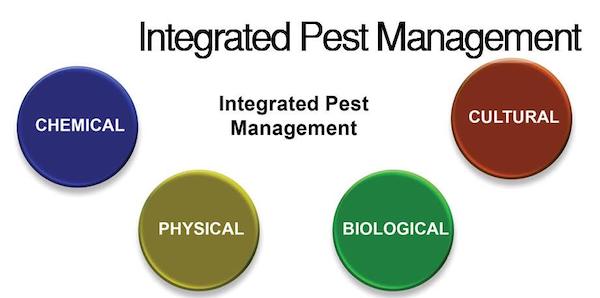Integrated Pest Management — What Does It Mean?
Gil Medeiros, Former Fairfax Master Gardener
 Integrated Pest Management, or IPM, has the ring of fine bureaucratese, as does any title which contains the word “integrated.” But don’t be misled: While it may sound like some empty terminology concocted by a paper pusher in a dim cubicle, IPM is an important concept that gardeners everywhere should understand.
Integrated Pest Management, or IPM, has the ring of fine bureaucratese, as does any title which contains the word “integrated.” But don’t be misled: While it may sound like some empty terminology concocted by a paper pusher in a dim cubicle, IPM is an important concept that gardeners everywhere should understand.
IPM is a way of controlling pests in garden beds and farm fields. It is built upon the premise that we should do as little harm to the environment as possible in controlling pests. For the farmer, it means controlling costs, as well as controlling pests. IPM combines all the best practices of pest management into a single system of pest control that reserves its harshest measures for the toughest problems. This is why “integrated” is in the name.
For the home gardener, IPM has three parts
Prevention
IPM emphasizes the application of many common-sense, simple, gardening practices, such as cleaning up garden waste, rotating crops, using barriers such as row covers, selecting disease and insect resistant varieties, and preparing the soil properly. It also includes fostering the presence of predator and parasitoid insect species to prevent the occurrence of pest infestations.
Monitoring and Identification
This means seeking evidence of a problem and determining what it is. The gardener is encouraged to scout garden beds for symptoms such as discoloration of leaves or wilting of the plant. The gardener also looks for signs, such as the insects themselves, their eggs or their waste products. The gardener is responsible for devising a regular schedule of monitoring and careful observation. The Identification part of this takes training, experience and sometimes research. This is where Fairfax County master gardeners and the Fairfax County Master Gardeners Association’s Diagnostic Laboratory can be of service.
Control
IPM first encourages use of the least hazardous approach to control. For example, Japanese beetles can be hand-picked from a rosebush; aphids can be washed off plant stems with water instead of using a poison. Predator and parasitoid insects can be purchased and released in your garden. Botanical controls that are highly specific to a particular insect (such Bt for caterpillars) can be used.
IPM reserves the use of broad spectrum toxic chemicals as a last resort to be employed when there is no other practical way to save a crop or an ornamental plant.
There are two key differences between IPM and organic gardening:
- Organic gardeners do not use synthetic pesticides as a last resort. They do not use them at all.
- Organic gardeners use only organic fertilizers made from decomposed plant and animal wastes and minerals that are mined from the earth. Practitioners of IPM are not limited in their selection of fertilizers.
 IPM traces its roots to the indiscriminate spraying of pesticides. Powerful chemicals such as DDT were routinely used in huge quantities to control pests. But the pests gradually developed resistance, and DDT was found to persist in the environment for years, damaging animal populations and threatening human health. Replacing one chemical with a newer one simply sent us around the circle again without solving the problem.
IPM traces its roots to the indiscriminate spraying of pesticides. Powerful chemicals such as DDT were routinely used in huge quantities to control pests. But the pests gradually developed resistance, and DDT was found to persist in the environment for years, damaging animal populations and threatening human health. Replacing one chemical with a newer one simply sent us around the circle again without solving the problem.
IPM gives farmers and gardeners a way to get off the pesticide carousel, protect the environment and save money.
References
History and Justification for IPM, Virginia Cooperative Extension, 1997
Integrated Pest Management (IPM) Principles, US Environmental Protection Agency